Digital Technology
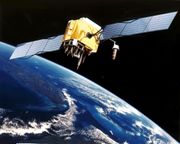
The Global Positioning System (GPS) is the only fully functional Global Navigation Satellite System (GNSS). Utilizing a constellation of at least 24 medium Earth orbit satellites that transmit precise microwave signals, the system enables a GPS receiver to determine its location, speed/direction, and time.
Developed by the United States Department of Defense, it is officially named NAVSTAR GPS (Contrary to popular belief, NAVSTAR is not an acronym, but simply a name given by Mr. John Walsh, a key decision maker when it came to the budget for the GPS program). The satellite constellation is managed by the United States Air Force 50th Space Wing. The cost of maintaining the system is approximately US$750 million per year, including the replacement of aging satellites, and research and development. Despite these costs, GPS is free for civilian use as a public good.
GPS has become a widely used aid to navigation worldwide, and a useful tool for map-making, land surveying, commerce, and scientific uses. GPS also provides a precise time reference used in many applications including scientific study of earthquakes, and synchronization of telecommunications networks.
Nokia N95 spot
Nokia N95-GPS Demo
ASIMO - the perfect brand spokesperson
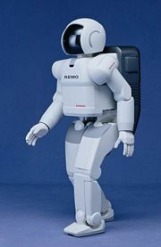
December 15, 2006 The world of personal robotics is drawing closer, with some estimates of the personal robotics industry putting it abreast with the world automotive industry two decades from now. Honda has already established itself as the world’s largest motorcycle manufacturer and has branched into a dozen different recreational and business markets as diverse as jet aeroplanes, jet skis, and industrial engines.
Its biggest market may be yet to come, because it has been working diligently for 20 years in the development of a bipedal humanoid service robot named Asimo and if it works half as well as the rest of the company's products, it'll be one of the pioneers into the home when robotic servants reach mass commercialisation. Asimo is already a well known brand but when Honda begins airing 90 second commercials in the UK later this week, where Asimo becomes the ideal fully-owned, never-makes-a-mistake brand spokesperson, we figure history is being made. Asimo embodies the Honda attitude towards technology – warm, approachable, human, optimistic and always moving forward – as the Honda spokesperson, he will become the first publicly known robot on a global scale, and he’ll evolve publicly across all languages. Honda's new warmtechnology web site goes live today, and there are also five short films available at www.honda.co.uk. The series of webcasts introduce Asimo, and show how its warm approach has brought science and technology to a broad audience across the world.
The ad depicts Asimo in a museum setting, engaging with a range of exhibits and everyday objects to demonstrate the robot’s human qualities and advanced technology. It closes with the thought: ‘More forwards please’ – which represents Honda’s continual push for technological innovation.
Head of Marketing at Honda (UK), Jeff Dodds, said: “We’re always looking to develop technology that is approachable and warm, and by that I mean innovations people can appreciate, engage with and relate to. ASIMO is a serious research project for Honda, but it also has the ability to put smiles on people’s faces and so embodies perfectly our ‘warm technology’ approach.”
Outdoor mega sites and large posters featuring Asimo will complement the TV campaign, showing the progression of Honda’s 20 year robot programme from the first pair of legs with a computer attached, to today's humanoid Asimo.
Before the campaign breaks, five short films will be broadcast daily from www.honda.co.uk. The series of webcasts introduce Asimo, and show how its warm approach has brought science and technology to a broad audience across the world.
From 15 December, a new website www.warmtechnology.co.uk goes live, which will feature a gallery space dedicated to Honda’s ‘more forwards please’ advancements. As well as Asimo, the FCX hydrogen fuel cell car, new HondaJet plane and CR-V are presented as examples of Honda’s approach to alternative technology.
DANCING SONY ROBOTS
ASIMO
4G
4G (also known as beyond 3G), an acronym for Fourth-Generation Communications System, is a term used to describe the next step in wireless communications. A 4G system will be able to provide a comprehensive IP solution where voice, data and streamed multimedia can be given to users on an "Anytime, Anywhere" basis, and at higher data rates than previous generations. There is no formal definition for what 4G is; however, there are certain objectives that are projected for 4G.
These objectives include: that 4G will be a fully IP-based integrated system. This will be achieved after wired and wireless technologies converge and will be capable of providing 100 Mbit/s and 1 Gbit/s speeds both indoors and outdoors, with premium quality and high security. 4G will offer all types of services at an affordable cost.
It is generally accepted that 4G networks will provide more than just wireless voice telecommunications. In fact, the main thrust of 4G technologies is to provide high-speed, high-bandwidth, packetized data communications. It is generally expected that in 4G even voice traffic will be delivered to the handset in packets (as opposed to delivery via dedicated circuit switching).
Circuit switching refers to the technique in which a dedicated channel is used to transmit and receive voice or data. Packetized data communications refers to the digital signaling technique in which information (voice or data) is converted into binary code and partitioned into short segments. These segments are then reassembled in the correct order and converted back into usable information at the destination.
Packet switching is more desirable to carriers and providers than circuit switching for a host of reasons. One reason is capacity. It is inefficient to serve only a single subscriber per channel because the full bandwidth of the channels is not being used at all times during a voice call. When a typical user makes a call, there are lulls where neither party is talking. In circuit switching, that lull is still being transmitted over the channel. The first generation of wireless (cellular) technology used this technique.
Current wireless systems share channels in a packet environment to deliver voice communications. In packet switching, only actual voice content is packetized and sent to the system. Advances in technology and in multiple access techniques have made this possible. Unfortunately, today’s wireless access techniques do not support high-speed or high-bandwidth transmissions. This limitation is the impetus for the evolution of wireless communications.
In today’s wireless marketplace, users demand value-added services. With all the hype heralding third-generation (3G) services, users have come to expect that the next generation of wireless technology will be not only a voice communications medium but will have Internet-like functionality. Service providers and application developers are on the path to realizing these user expectations, but there is still a long road ahead.
In reality, the dream of Internet-style functionality via wireless communications may not be fully realized in the 3G deployment. The multiple access techniques planned for 3G will not support the bandwidth and data transmission speeds required for the advanced applications users expect. 3G technologies will certainly have greater functionality than today’s wireless systems; however, not until 4G deployment will these so called “killer” applications be supported.
4G MOBILE PHONE
International Space Station (ISS)
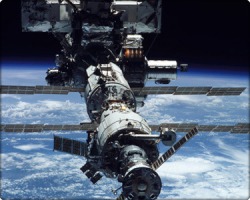
The International Space Station orbits around the Earth at an altitude of 360km. The construction of this beneficial satellite was a joint effort, bringing together the resources of NASA, the Russian Federal Space Agency, the Japan Aerospace Exploration Agency, the Canadian Space Agency and the European Space Agency. During the early 1980s, the United States planned for the NASA International Space Station to be a counterpart for the Soviet stations Salyut and Mir, but construction was never implemented. The resolution of the Cold War and the end of the race to space triggered international efforts to rekindle the project.
The International Space Station was finally launched on November 20, 1998 to begin its first 92-minute trip around the Earth. The first permanent crew of astronauts arrived on the International Space Station on November 2, 2000. Since then, there have always been at least two people on board. So far, the astronauts residing on the space station have been American or Russian.
In addition to the astronauts who have resided on the International Space Station, space tourists have also visited the shuttle. Dennis Tito was the first person to visit space as a tourist. After his visit, Yuri Malecnchenko and Ekaterina Dmitriev were married on the International Space Station.
NASA International Space Station
Electronics
Electronics is the study of the flow of charge through various materials and devices such as, semiconductors, resistors, inductors, capacitors, nano-structures, and vacuum tubes. All applications of electronics involve the transmission of power and possibly information.
Although considered to be a theoretical branch of physics, the design and construction of electronic circuits to solve practical problems is an essential technique in the fields of electronics engineering and computer engineering.
The study of new semiconductor devices and surrounding technology is sometimes considered a branch of physics. This article focuses on engineering aspects of electronics. Other important topics include electronic waste and occupational health impacts of semiconductor manufacturing.
Overview of electronic systems and circuits Commercial digital voltmeter checking a prototypeElectronic systems are used to perform a wide variety of tasks. The main uses of electronic circuits are:
The controlling and processing of data. The conversion to/from and distribution of electric power. Both these applications involve the creation and/or detection of electromagnetic fields and electric currents. While electrical energy had been used for some time prior to the late 19th century to transmit data over telegraph and telephone lines, development in electronics grew exponentially after the advent of radio.
One way of looking at an electronic system is to divide it into 3 parts:
Inputs
Electronic or mechanical sensors (or transducers). These devices take signals/information from external sources in the physical world (such as antennas or technology networks) and convert those signals/information into current/voltage or digital (high/low) signals within the system.
Signal processors
These circuits serve to manipulate, interpret and transform inputted signals in order to make them useful for a desired application. Recently, complex signal processing has been accomplished with the use of Digital Signal Processors.
Outputs
Actuators or other devices (such as transducers) that transform current/voltage signals back into useful physical form (e.g., by accomplishing a physical task such as rotating an electric motor). For example, a television set contains these 3 parts. The television's input transforms a broadcast signal (received by an antenna or fed in through a cable) into a current/voltage signal that can be used by the device. Signal processing circuits inside the television extract information from this signal that dictates brightness, colour and sound level. Output devices then convert this information back into physical form. A cathode ray tube transforms electronic signals into a visible image on the screen. Magnet-driven speakers convert signals into audible sound.
MICROSOFT oPHONE
MICROSOFT SURFACE PARODY
NASA set to support UK moon probe
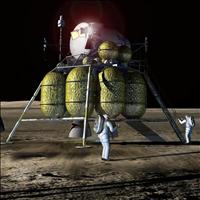
NASA is set to support plans to send a British probe to the Moon by 2012, it has been reported. According to the BBC, the US space agency would be keen to use UK expertise to carry out scientific studies.
It also revealed in the future, Britain may also set up observatories on the moon's surface.Earlier this year, it was reported that UK scientists had developed a proposal, called project MoonLite, to send a probe into lunar orbit.A study to be published in January has described the MoonLite plan as "inspirational" concluding that it fills the right gap in Nasa's exploration programme.
The report is so positive that the BBC believes Nasa will ask the UK space community to carry out a detailed feasibility study by the end of next summer.If all goes as expected, Nasa will officially back and become involved in the project next summer. It is also thought the Indian Space Agency will be a partner, although the project will be UK-led.The concept has been developed by Mullard Space Sciences Laboratory (MSSL) and Surrey Satellite Technology Limited (SSTL).
The idea would be to send a probe to orbit the moon, which would then fire four suitcase-sized darts called "penetrators" at it allowing the scientists to scratch below the lunar surface.Once embedded under the surface, instruments in the penetrator would listen out for "Moonquakes". Analysis of these tremors would shed more light on the chemical and physical structure of the Moon's interior.
Moon Return Video
NASA robot in Mars
What is Biotechnology?
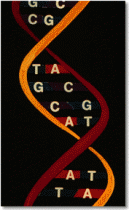
In it’s present form, the term “biotechnology” refers to the use of living organisms or their products to modify human health and the human environment.
The term “biotechnology” was coined in 1919 by Karl Ereky, an Hungarian engineer. Biotechnology has been described as “Janus faced”. This implies that there are two sides. On one, techniques that allow DNA to be manipulated, i.e. to move genes from one organism to another. On the other hand, it involves relatively new technologies whose consequences are untested and should be met with caution. for e.g. stem cells, gene therapy, genetically modified organisms.
Biotechnology in one form or another has flourished since prehistoric times. When the first human beings realized that they could plant their own crops and breed their own animals, they learned to use biotechnology. The discovery that fruit juices fermented into wine, or that milk could be converted into cheese or yogurt, or that beer could be made by fermenting solutions of malt and hops began the study of biotechnology. When the first bakers found that they could make a soft, spongy bread rather than a firm, thin cracker, they were acting as fledgling biotechnologists. The first animal breeders, realizing that different physical traits could be either magnified or lost by mating appropriate pairs of animals, engaged in the manipulations of biotechnology.
The term ‘biotechnology’ brings to mind many different things. Some think of developing new types of animals. Others dream of almost unlimited sources of human therapeutic drugs. Still others envision the possibility of growing crops that are more nutritious and naturally pest-resistant to feed a rapidly growing world population. This question elicits almost as many first-thought responses as there are people to whom the question can be posed.
Prehistoric biotechnologists did this as they used yeast cells to raise bread dough and to ferment alcoholic beverages, and bacterial cells to make cheeses and yogurts and as they bred their strong, productive animals to make even stronger and more productive offspring.
Throughout human history, we have learned a great deal about the different organisms that our ancestors used so effectively. The marked increase in our understanding of these organisms and their cell products gains us the ability to control the many functions of various cells and organisms. Using the techniques of gene splicing and recombinant DNA technology, we can now actually combine the genetic elements of two or more living cells. Functioning lengths of DNA can be taken from one organism and placed into the cells of another organism. As a result, for example, we can cause bacterial cells to produce human molecules. Cows can produce more milk for the same amount of feed. And we can synthesize therapeutic molecules that have never before existed.
BIOTECHNOLOGY
TAIPEI 101 - the world's tallest building
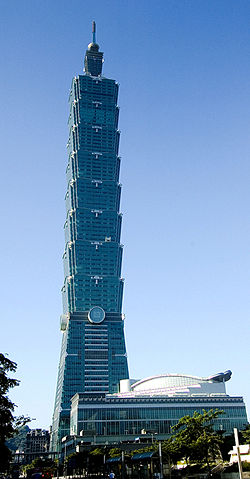
The world's tallest building is now in Taiwan. With a height of 508 meters--and 101 stories above ground and five stories below-the Taipei 101 building has surpassed the 462-meter Sears Tower in Chicago and the 451-meter Petronas Twin Tower in Malaysia to acquire the title "world's tallest building."
Designed by world-renowned architect C.Y. Lee, the exterior of the building resembles bamboo segments, with eight stories to each segment because the number "8" signifies prosperous growth. Each segment is shaped like a scepter, with ancient coins on the exterior of the 26th floor to give this modern building a Chinese style.
Taipei 101 also has the world's fastest elevators. These can transport passengers to the 89th-floor observatory in a mere 39 seconds. Each one of these 1000-meter-per-minute elevators cost more than NT$68 million. To prevent the building from swaying during typhoons or earthquakes, an 800-ton, US$4 million, ball-shaped damper is used to dissipate lateral vibration to a spring system underneath. For the first time in architectural history, the damping system is is not hidden, but part of the building's design. This world's largest damper ball has a diameter of 5.5 meters and is visible from the 88th and 89th floors.Taipei 101 was opened to the public on December 31, 2004.
TAIPEI is mnemonic for Technology, Art, Innovation, People, Environment, and Identity. 101 represents the concept of striving for beyond perfection.
Taipei 101, whose pinnacle reached full height on Oct. 9, 2003, is currently the official world's tallest building in the categories of highest structurally, highest roof, and highest occupied floor. The Sears Tower in Chicago holds the fourth category of overall height.
The multi-use structure will house retail facilities on Levels 1-4; a fitness center on Levels 5-6; offices on Levels 7-84; restaurants on Levels 86-88; observation decks on Levels 89, 91, and 101; and communication facilities on Levels 92-100.
There is a station for the Taipei Mass Rapid Transit (MRT) beneath the building awaiting the eventual construction of the Hsinyi line.
Bringing Taipei to the world
Taipei 101 will soon become a new world landmark. Taipei City Government plans to feature the building in its 2004 New Year's Eve Celebrations; dazzling lights will count down the 10-bamboo segmented building, segment by segment, as the year ends and a new year begins. The building will, as Mayor Ma Ying-jeou says, "Bring Taipei to the world!"
